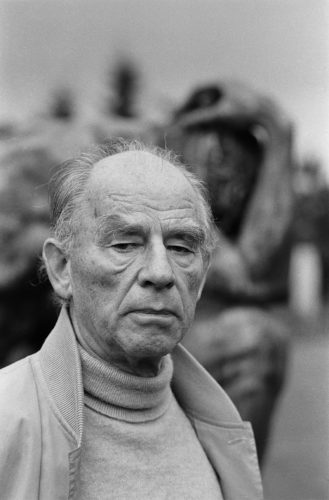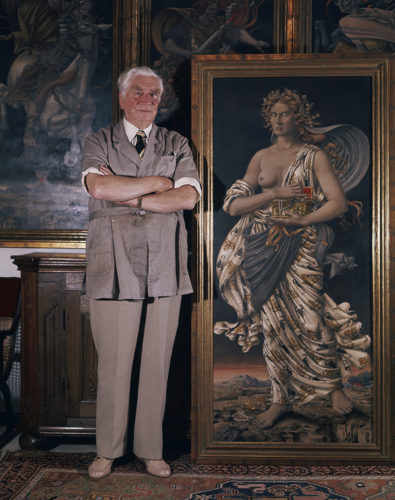Pierre Boulat
-

Arno Breker (1900-1991) - His sculptures were promoted by the Nazi authorities as the antithesis of "degenerate art. Hitler who considered him one of the artistic geniuses of the Third Reich insisted that he and Albert Speer accompany him on his visit to Paris on June 23, 1940, after the German troops had entered the French capital. Arno Breker was never prosecuted for fulfilling the commissions placed by the Nazi regime, and he always refused to express regret or apology, claiming that artists had nothing to do with politics. It seems that he never adhered to the racist National Socialist ideology but accepted the regime out of "opportunism and megalomania".
-
In the garden of the Museum Arno Breker à Nörvenich, 1974 -

Arno Breker (1900-1991) - His sculptures were promoted by the Nazi authorities as the antithesis of "degenerate art. Hitler who considered him one of the artistic geniuses of the Third Reich insisted that he and Albert Speer accompany him on his visit to Paris on June 23, 1940, after the German troops had entered the French capital. Arno Breker was never prosecuted for fulfilling the commissions placed by the Nazi regime, and he always refused to express regret or apology, claiming that artists had nothing to do with politics. It seems that he never adhered to the racist National Socialist ideology but accepted the regime out of "opportunism and megalomania".
-

Arno Breker (1900-1991) - Arno Breker (1900-1991) - His sculptures were promoted by the Nazi authorities as the antithesis of "degenerate art. Hitler who considered him one of the artistic geniuses of the Third Reich insisted that he and Albert Speer accompany him on his visit to Paris on June 23, 1940, after the German troops had entered the French capital. Arno Breker was never prosecuted for fulfilling the commissions placed by the Nazi regime, and he always refused to express regret or apology, claiming that artists had nothing to do with politics. It seems that he never adhered to the racist National Socialist ideology but accepted the regime out of "opportunism and megalomania".
-
In the garden of the Museum Arno Breker à Nörvenich, 1974 -

Arno Breker (1900-1991) - Arno Breker (1900-1991) - His sculptures were promoted by the Nazi authorities as the antithesis of "degenerate art. Hitler who considered him one of the artistic geniuses of the Third Reich insisted that he and Albert Speer accompany him on his visit to Paris on June 23, 1940, after the German troops had entered the French capital. Arno Breker was never prosecuted for fulfilling the commissions placed by the Nazi regime, and he always refused to express regret or apology, claiming that artists had nothing to do with politics. It seems that he never adhered to the racist National Socialist ideology but accepted the regime out of "opportunism and megalomania".
-
In the garden of the Museum Arno Breker à Nörvenich, 1974 -

Werner Peiner (1897-1984) had become one of the best known and most talented official painters. Although initially influenced by expressionism, his main influences came from German romantic and realist paintings. A personal friend of Goering, he was entrusted in 1942, the realization of a great project: a series of 10 tapestries of 10 meters by 4 meters, for the new chancellery of Berlin. To execute these tapestries, Goering had planned to transport the entire french Gobelins team to Berlin. This finally never happened.
-
In his studio, where he lived for 25 years, "Haus Vorst" in front of a series of 24 paintings called "Demons of the Hour" (Demons of the Apocalypse) painted in 1944. Leichlingen 1974 -

Werner Peiner (1897-1984) had become one of the best known and most talented official painters. Although initially influenced by expressionism, his main influences came from German romantic and realist paintings. A personal friend of Goering, he was entrusted in 1942, the realization of a great project: a series of 10 tapestries of 10 meters by 4 meters, for the new chancellery of Berlin. To execute these tapestries, Goering had planned to transport the entire french Gobelins team to Berlin. This finally never happened.
-
In his studio, where he lived for 25 years, "Haus Vorst" in front of a series of 24 paintings called "Demons of the Hour" (Demons of the Apocalypse) painted in 1944. Leichlingen 1974 -

Werner Peiner (1897-1984) had become one of the best known and most talented official painters. Although initially influenced by expressionism, his main influences came from German romantic and realist paintings. A personal friend of Goering, he was entrusted in 1942, the realization of a great project: a series of 10 tapestries of 10 meters by 4 meters, for the new chancellery of Berlin. To execute these tapestries, Goering had planned to transport the entire french Gobelins team to Berlin. This finally never happened.
-
In his studio, where he lived for 25 years, "Haus Vorst" in front of a series of 24 paintings called "Demons of the Hour" (Demons of the Apocalypse) painted in 1944. Leichlingen 1974 -

Werner Peiner (1897-1984) had become one of the best known and most talented official painters. Although initially influenced by expressionism, his main influences came from German romantic and realist paintings. A personal friend of Goering, he was entrusted in 1942, the realization of a great project: a series of 10 tapestries of 10 meters by 4 meters, for the new chancellery of Berlin. To execute these tapestries, Goering had planned to transport the entire french Gobelins team to Berlin. This finally never happened.
-
in his studio, where he lived for 25 years, "Haus Vorst" in front of a series of 24 paintings called "Demons of the Hour" (Demons of the Apocalypse) painted in 1944. Leichlingen 1974 -

Albert Speer (1905-1981) was the third of the glorious artistic trilogy of the Third Reich. As an architect, he was in charge of pharaonic projects in Berlin. Very close to the Führer, for whom he had boundless admiration, he was also his minister for armaments and war production. After the fall of the Third Reich, Speer was one of the Nazi dignitaries tried at Nuremberg. He was sentenced to twenty years in prison, which he served in its entirety in Spandau prison, despite the support of eminent statesmen such as De Gaulle and Willy Brandt.
-
At home in Heidelberg, 1974 -

Albert Speer (1905-1981) was the third of the glorious artistic trilogy of the Third Reich. As an architect, he was in charge of pharaonic projects in Berlin. Very close to the Führer, for whom he had boundless admiration, he was also his minister for armaments and war production. After the fall of the Third Reich, Speer was one of the Nazi dignitaries tried at Nuremberg. He was sentenced to twenty years in prison, which he served in its entirety in Spandau prison, despite the support of eminent statesmen such as De Gaulle and Willy Brandt.
-
At home in Heidelberg, 1974 -

Albert Speer (1905-1981) was the third of the glorious artistic trilogy of the Third Reich. As an architect, he was in charge of pharaonic projects in Berlin. Very close to the Führer, for whom he had boundless admiration, he was also his minister for armaments and war production. After the fall of the Third Reich, Speer was one of the Nazi dignitaries tried at Nuremberg. He was sentenced to twenty years in prison, which he served in its entirety in Spandau prison, despite the support of eminent statesmen such as De Gaulle and Willy Brandt.
-
At home in Heidelberg, 1974 -

Albert Speer (1905-1981) was the third of the glorious artistic trilogy of the Third Reich. As an architect, he was in charge of pharaonic projects in Berlin. Very close to the Führer, for whom he had boundless admiration, he was also his minister for armaments and war production. After the fall of the Third Reich, Speer was one of the Nazi dignitaries tried at Nuremberg. He was sentenced to twenty years in prison, which he served in its entirety in Spandau prison, despite the support of eminent statesmen such as De Gaulle and Willy Brandt.
-
At home in Heidelberg, 1974 -

Albert Speer (1905-1981) was the third of the glorious artistic trilogy of the Third Reich. As an architect, he was in charge of pharaonic projects in Berlin. Very close to the Führer, for whom he had boundless admiration, he was also his minister for armaments and war production. After the fall of the Third Reich, Speer was one of the Nazi dignitaries tried at Nuremberg. He was sentenced to twenty years in prison, which he served in its entirety in Spandau prison, despite the support of eminent statesmen such as De Gaulle and Willy Brandt.
-
At home in Heidelberg, 1974
Artists of the 3rd Reich
-
They had their moment of glory during the Nazi regime


